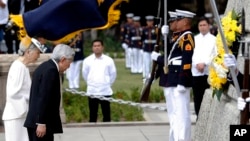Japan's royal couple arrived in the Philippines Wednesday for a historic five-day visit marking six decades of formal diplomatic ties between the two nations.
President Benigno Aquino greeted Emperor Akihito and Empress Michiko with a red carpet ceremony at Malacanang Palace, the official presidential residence, complete with a traditional honor guard and gun salute.
Outside the palace, several hundred people rallied to demand justice for women forced into sexual slavery by women by Japanese forces during the war.
Aquino and Emperor Akihito held talks at the palace before attending a ceremony at the country's largest war cemetery to honor those who died during Japan's occupation of the Philippines.
Tens of thousands Filipino soldiers died marching to Japanese concentration camps or during confinement.
Later, at a state banquet the emperor recalled the fierce battles between Japanese and American forces in the Philippines that resulted in the deaths of an estimated 100,000 Filipinos.
"Last year Japan marked the 70th anniversary of the end of World War II," Emperor Akihito said.
"During this war, fierce battles between Japan and the United States took place on Philippine soil, resulting in the loss of many Filipino lives and leaving many Filipinos injured. This is something we Japanese must never forget and we intend to keep this engraved in our hearts throughout our visit."
The visit, the first by a sitting Japanese emperor and empress to the Philippines, symbolizes the deepening ties between the Pacific island nations that took root years after Japan's brutal occupation of the Philippines during World War II. More than one million people died during the occupation, including hundreds of thousands killed as U.S. and Philippine forces battled the Japanese to retake control of Manila in 1945.










